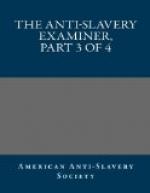EXTRACTS FROM DEBATES IN THE SEVERAL STATE CONVENTIONS ON THE ADOPTION OF THE UNITED STATES’ CONSTITUTION.
* * * * *
MASSACHUSETTS CONVENTION.
The third paragraph of the 2d section being read,
Mr. KING rose to explain it. There has, says he, been much misconception of this section. It is a principle of this Constitution, that representation and taxation should go hand in hand. This paragraph states, that the number of free persons shall be determined, by adding to the whole number of free persons, including those bound to service for a term of years, and excluding Indians not taxed, three-fifths of all other persons. These persons are the slaves. By this rule is representation and taxation to be apportioned. And it was adopted, because it was the language of all America.
Mr. WIDGERY asked, if a boy of six years of age was to be considered as a free person?
Mr. KING in answer said, all persons born free were to be considered as freemen; and to make the idea of taxation by numbers more intelligible, said that five negro children of South Carolina, are to pay as much tax as the three Governors of New Hampshire, Massachusetts, and Connecticut.
Mr. GORHAM thought the proposed section much in favor of Massachusetts; and if it operated against any State, it was Pennsylvania, because they have more white persons bound than any other.
Judge DANA, in reply to the remark of some gentlemen, that the southern States were favored in this mode of apportionment, by having five of their negroes set against three persons in the eastern, the honorable judge observed, that the negroes of the southern States work no longer than when the eye of the driver is on them. Can, asked he, that land flourish like this, which is cultivated by the hands of freemen? Are not three of these independent freemen of more real advantage to a State, than five of those poor slaves?
Mr. NASSON remarked on the statement of the honorable Mr. KING, by saying that the honorable gentleman should have gone further, and shown us the other side of the question. It is a good rule that works both ways—and the gentleman should also have told us, that three of our infants in the cradle, are to be rated as high as five of the working negroes of Virginia. Mr. N. adverted to a statement of Mr. KING, who had said, that five negro children of South Carolina were equally rateable as three governors of New England, and wished, he said, the honorable gentleman had considered this question upon the other side—as it would then appear that this State will pay as great a tax for three children in the cradle, as any of the southern States will for five hearty working negro men. He hoped, he said, while we were making a new government, we should make it better than the old one: for if we had made a bad bargain before, as had been hinted, it was a reason why we should make a better one now.




